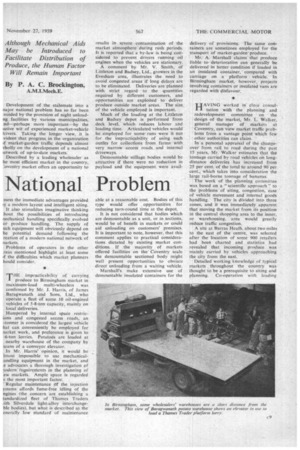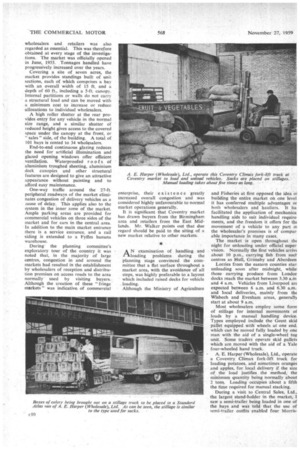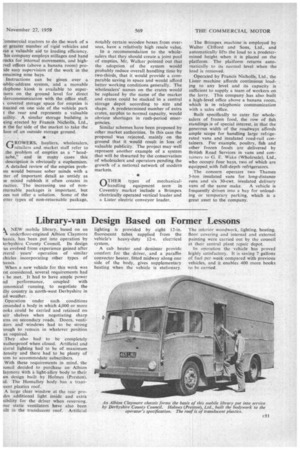MARKET PLANNING National Problem
Page 48

Page 49

Page 50

Page 51

If you've noticed an error in this article please click here to report it so we can fix it.
"There are many frustrating delays in and around many of our markets causing serious inefficiency of operation which adds to the overall costs of marketing and distribution. Comprehensive reorganizationand rebuilding and, in some . cases, entire resiting of markets should provide the solution."
THESE comments and recommendations are contained in the report of the Horticultural Marketing Advisory Council on the transport of market-garden produce and on methods of reducing damage. Earlier in the report it is pointed out that: "The provision of mechanical aids for moving produce in the markets and ;other places where produce is concentrated' could be . expected to improve handling, but a pre-requisite might well ,N., improv'ed -layout of Marketsand -distributing centre*, and the more widespread adoptionof standard packages."
My investigation of . produce market traffic in the Midland area was initially concentrated on loading and. -packaging methods that could be used .to reducehandling time and damage. • Information obtained from hauliers and growers in the Evesham area, from wholesalers and retailers in Birmingham and from reports of traffic in other parts of the country showed that . differences. of opinion related, mainly to detail that; was of importance. only when applied to individual . problems. In practically' every case the driVer was. cited as the Most important element in promoting transport
efficiency.' . . . ' . . _ 'Drivers' knowledge of the characteristics of produce and of handling mixed loads in many types of package or crate was claimed to be essential for the avoidance. of damage and delay. The integrity 01
of drivers was also mentioned as a necessary qualification, and this was linked to "knowing their way around." No one reported a high incidence of damage, and isolated examples were attributed to inexperience or laxity on the part of the driver.
It was repeatedly stated that mechanical loading aids could not facilitate handling, because it was normally necessary to deliver parts of a single load to a number of wholesalers and because variations in sizes and shapes of packages precluded loading in definite sections. The cramped space in the great majority of markets and heavy congestion would, it was claimed. create insurmountable difficulties in any scheme to introduce more advanced types of mechanical handling.
Interviews with the ,staff of Marshall's Transport, Evesham, revealed that facilities for unloading by night at "Wholesale markets were essential' to efficientfleet organization, in that they obviated delays through congestion and enabled trunk runs
to.. be timetabled. Such facilities are provided at most centres to which deliveries arc made, including the markets at Bristol, Bradford and Leeds.
Many markets, including Birmingham, are officially closed during the night, and vehicles may, be delayed for long periods while waiting for the market to open or for other vehicles to -unload before they can gain access. Moreover, advantages of unloading by night cannot be fully exploited by a substantial proportion of operators.
Because of 'the distances involved, Many cannot deliver in the market during the night or cannot •do so without disrupting fleet organitat i on. This particularly relates to operators of maximumload eight-wheelers and so on who deliver parts of a load to different
markets. The size of the vehicle often adds to access difficulties.
E'ROM these observations it might be concluded that there is a stalemate in the organization of produce traffic and in the development of more efficient loading techniques.
The antiquity of most existing markets in large centres of population and their position in relation to focal points of traffic in the district often exacerbate congestion difficulties internally and externally for visiting vehicles, to the point of creating chaos. Moreover, all road users within a wide radius of the market may be affected. • Development of the stalemate into a najor national problem has so far been .voided by the provision of night unloadng facilities by various municipalities, .nd—perhaps more important—by the iative wit of experienced market-vehicle [rivers. Taking the longer view, it is vident that progress in the organization d market-garden traffic depends almost vholly on the development of a national ietwork of up-to-date markets.
Described by a leading wholesaler as he most efficient market in the country, .'.oventry market offers an opportunity to ssess the immediate advantages provided • y a modern layout and intelligent siting.
It also stimulates imaginative thinking bout the possibilities of introducing nechanical handling specifically evolved or produce handling. The supply of uch equipment will obviously depend on he potential demand following the rcation of a modern national network of narkets.
Problems of operators in the other reas mentioned highlight at least some if the difficulties which market planners hould consider.
THE impracticability of carrying, produce to Birmingham market in maximum-load multi-wheelers was confirmed by Mr. J. Harris, of James Baragwanath and Sons, Ltd., who operate a fleet of some 10 oil-engined vehicles of 5-8-ton capacity, mainly on local deliveries.
Hampered by internal space restricions and congested access roads, an „limner is considered the largest vehicle hat can conveniently be employed for aarket work, and preference is given to -6-ton lorries. Potatoes are loaded at nearby warehouse of the company by scans of a conveyor elevator.
In Mr. Harris' opinion, it would be lmost impossible to use mechanicalandling equipment in the market, and e advocates a thorough investigation of iodern requirements in the planning of ew markets. Ample space is regarded s the most important factor.
Regular maintenance a the injection ysterns affords fume-free idling of the ngines (the concern are establishing a tandardized fleet of Thames Traders rith Silverdale light-alloy interchangeble bodies), but what is described as the enerally low standard of maintenance
results in severe contamination of the market atmosphere during rush periods. It is reported that a by-law is being considered to prevent drivers running oil engines when the vehicles are stationary.
A comment by Mr. V. Smith, of Littleton and Badsey, Ltd., growers in the Evesham area, illustrates the need to avoid congested areas if long delays are to be eliminated. Deliveries are planned with strict regard to the quantities required by different customers, and opportunities are exploited to deliver produce outside market areas. The size. of the vehicle employed is important.
Much of the loading at the Littleton and Badsey depot is performed from deck level, which reduces labour and loading time. Articulated vehicles would be employed for some' runs were it not for the impracticability of using such outfits for collections from farms with very narrow access roads. and internal driveways. • Demountable stillage bodies would be attractive if there were no reduction in payload and the equipment were avail able at a reasonable cost. Bodies of this type would offer opportunities for reducing turn-round time at the depot.
It is not considered that bodies which are demountable as a unit, or in sections, would be of benefit in markets or could aid unloading on customers' premises. It is important to note, however, that this comment applies to practical considerations dictated by existing market conditions. If the majority of markets offered facilities on the Coventry scale the demountable sectioned body might well present opportunities to obviate direct unloading from a waiting vehicle.
Marshall's make extensive use of demountable insulated containers for the delivery of provisions. The same container S are sOmetimes employed for the
-transport Of market-garden' produce. •
Mr. A. Marshall claims that produce liable to deterioration can generally be delivered in better condition if loaded in an insulated container, compared with carriage on a platform vehicle. In Birmingham market, however. projects involving containers or insulated vans are regarded with disfavour.
HAVING worked in clo:;e consultation with the planning and redevelopment committee on -the design of the market, Mr. L. Walker, general manager of markets at Coventry, can view market traffic problems from a vantage Point which few other authorities can claim.
In .a personal appraisal of the changeover from rail to road during the past 15 years, Mr. Walker estimates that the tonnage carried by road vehicles On longdistance deliveries has increased from 25 per cent, of the total to around 90 per cent., which takes into consideration the large rail-borne tonnage of bananas.
The work of the planning committee was based on a "scientific approach" to the problems of siting, congestion, ease of vehicle movement and internal goods handling. The city is divided into three zones, and it was immediately apparent that moving the market from its position in the central shopping area to the inner, or warehousing. area would greatly reduce traffic congestion.
A site at Barras Heath. about two miles to the east of the centre, was selected after the location of some 900 retailers had been charted and statistics had revealed that incoming produce was mainly carried by vehicles approaching the city from the east.
Detailed working knowledge of typical markets throughout the country was thought to be a prerequisite to siting and planning. Co-operation with leading wholesalers and retailers was also regarded as essential. This was therefore obtained at every stage of the investigations. The market was officially opened in June, 1955. Tonnages handled have progressively increased over the years.
Covering a site of seven acres, the market provides standings built of unit sections, each of which comprises a bay with an overall width of 15 ft. and a depth of 60 ft., including a 5-ft. canopy. Internal partitions or walls do not carry a structural load and can be moved with a minimum cost to increase or reduce allocations to individual wholesaler& A high roller shutter at the rear provides entry for any vehicle in the normal size range, and a similar shutter of reduced height gives access to the covered space under the canopy at the front, or " sales " side, of the building. A total of 101 bays is rented to 34 wholesalers.
End-to-end continuous glazing reduces the need for artificial illumination and glazed opening windows offer efficient ventilation. Waterproofed roof s of aluminium troughed sheeting, aluminium deck canopies and other structural features are designed to give an attractive appearance without painting and to afford easy maintenance.
One-way traffic around the 27-ft. peripheral roadways of the market eliminates congestion of delivery vehicles as a muse of delay. This applies also to the system in the inner zone of the market. Ample parking areas are provided for commercial vehicles on three sides of the market and for cars in the central area. In addition to the main market entrance there is a service entrance, and a rail siding is extended to a Fyffes banana warehouse.
Duringthe planning committee's exploratory tour of the country it was noted that, in the majority of large centres, congestion in and around the markets had resulted in the establishment by wholesalers of reception and distribution premises on access roads to the area normally used by visiting buyers. Although the creation of these "fringe markets" was indicative, of commercial
enterprise, their exis tence greatly increased overall congestion and was considered highly unfavourable to normal market operations generally.
It is significant that Coventry market has drawn buyers from the Birmingham area and retailers from the East Midlands. Mr. Walker points out that due regard should be paid to the siting of a new market relative to other markets.
AN examination of handling and loading problems during the planning stage convinced the committee that a flat surface throughout a market area, with the avoidance of all steps, was highly preferable to a layout which included raised decks for vehicle loading.
Although the Ministry of Agriculture and Fisheries at first opposed the idea ol building the entire market on one level it has conferred multiple advantages or both wholesalers and bauliers. It ha. facilitated the application of mechanica handling aids to suit individual requirements, and the freedom it offers for du movement of a vehicle to any part 01 the wholesaler's premises is of compar able importance in many cases.
The market is open throughout the night for unloading under official supervision. Normally the first vehicles arrive about 10 p.m., carrying fish from suet centres as Hull, Grimsby and Aberdeen Lorries from the eastern counties star unloading soon after midnight, whilsi those• carrying produce from Londor docks reach the market between 3.30 a.m and 4 a.m. Vehicles from Liverpool are expected between 6 a.m. and 6.30 a.m. and local deliveries, mainly from the Wisbech and Evesham areas, generally start at about 9 a.m.
Most wholesalers employ some form of stillage for internal movements of loads by a manual handling device. Types employed include the Geest skid pallet equipped with wheels at one end, which can he moved fully loaded by one man with the aid of a single-wheel tug unit. Some traders operate skid pallets which are moved with the aid of a Yale four-wheeled hand truck.
A. E. Harper (Wholesale), Ltd., operate a Coventry Climax fork-lift truck for loading potatoes, and sometimes oranges and apples, for local delivery if the size of the load justifies the method, the minimum quantity being normally about 2 tons. Loading occupies about a fifth the time required for manual stacking.
During a visit to Central Sales, Ltd., the largest stand-holder in the market, saw a semi-trailer being loaded in one of the bays and was told that the use of semi-trailer outfits enabled four Morris .',ommercial tractors to do the work of a ar greater number of rigid vehicles and iras a valuable aid to loading efficiency. his company employs stillages and hand rucks for internal movements, and highwel offices (above a banana room) proide easy supervision of the work in the emaining nine bays.
Instructions can be given over a iublic-address system, and a movable elephone kiosk is available to superisors on the ground level for direct liercommunication with the office staff. 1 covered storage space for empties is ituated on one side of the vehicle park t the rear and represents a valuable lathy. A similar storage building is eing erected by Francis Nicholls, Ltd., n the far side of the market to take the lace of an outside storage ground.
GROWERS, hauliers. wholesalers, retailers and market staff refer to the problem of empties as a " headache," and in many cases this description is obviously a euphemism. A detailed review of the empties prob
!in would bemuse sober minds with a tter of important detail as untidy as le mixed rubbish it often creates in ractice. The increasing use of nonaturnable packages is important, but oes not offer a solution. Some of the etter types of non-returnable package, notably certain wooden boxes from overseas, have a relatively high resale value.
In a recommendation to the wholesalers that they should create a joint pool of empties, Mr. Walker pointed out that the adoption of the system would probably reduce overall handling time by two-thirds, that it would provide a comparable saving in space and would afford better working conditions generally. The wholesalers' names on the crates would be replaced by the name of the market and crates could be stacked in a central storage depot according to size and shape. A predetermined number of extra crates, surplus to normal capacity, would obviate shortages in rush-period emergencies.
Similar schemes have been proposed by other market authorities. In this case the proposal was rejected, mainly on the ground that it would result in loss of valuable publicity. The project may well represent another example of a system that will be thwarted by the conservatism of wholesalers and operators pending the growth of a national network of modern markets.
OTHER types of mechanicalhandling equipment seen in Coventry market include a Brimpex electrically operated vertical loader and a Lister electric conveyor loader.
The Brimpex machine is employed by Walter Clifford and Sons, Ltd., and automatically lifts the load to a predetermined height when it is placed on the platform. The platform returns automatically to its normal level when the load is removed.
Operated by Francis Nicholls, Ltd., the Lister machine affords continuous loading to any level and its capacity is sufficient to supply a team of workers on the lorry. This company has also built a high-level office above a banana room, which is in telephonic communication with a sales office.
Built specifically to cater for wholesalers of frozen food, the row of fish standings is of special interest, in that the generous width of the roadways affords ample scope for handling large refrigerated vans and insulated road-rail containers. For example, poultry, fish and other frozen foods are delivered by British Road Services in vans and containers to G. E. Wake (Wholesale), Ltd., who occupy four bays, two of which are equipped with full-depth refrigerators.
The concern operates two Thames 5-ton insulated vans for long-distance runs and six 30-cwt, insulated delivery vans of the same make. A vehicle is frequently driven into a hay for unloading or temporary parking, which is a great asset to the company.
















































































































